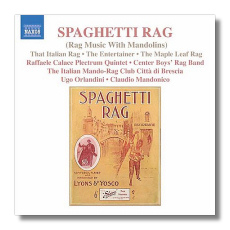
The Internet's Premier Classical Music Source
Related Links
- Latest Reviews
- More Reviews
-
By Composer
-
Collections
DVD & Blu-ray
Books
Concert Reviews
Articles/Interviews
Software
Audio
Search Amazon
Recommended Links
Site News
 CD Review
CD Review
Spaghetti Rag

Rag Music with Mandolins
- Al Piantadosi:
- That Italian Rag 3,8
- The Funny Old Fakir 4,6
- Abe Holzmann: Bunch O' Blackberries 4,5
- Edward George: A'Frangesa 4,5
- George Lyons/Bob Yosco: Spaghetti Rag 3,8
- Nicola Moleti: Lady of My Hearts Rag 3
- Scott Joplin:
- The Entertainer 3,8
- Solace, A Mexican Serenade 1
- The Maple Leaf Rag 3,8
- E. Oisorak (Ermenegildo Carosio):
- Ragtime 2
- Detective Rag 2
- Flirtation Rag 2
- George Linus Cobb:
- Rubber Plant Rag 3,8
- Russian Rag 1
- Robert George Ingraham: Mando Rag 3,8
- Julius Lenzberg: Operatic Rag 3,8
- Neil Gladd: The Red Bach Book:
- Ragtime Offering 1
- The Goldberg Rag 4,7,8
- The Art of Rag 3,8
- Claudio Mandonico: Calace Rag 3,8
1 Raffaele Calace Plectrum Quartet
2 Center Boys' Rag Band
3 The Italian Mando-Rag Club Città di Brescia
4 Ugo Orlandi, mandolin and banjo-mandolin
5 Alessandro Bono, guitar
6 Maura Mazzonetto, piano
7 Daniele Bosio, bass tuba
8 Claudio Mandonico, piano
Naxos 8.557999 DDD 70:35
Scott Joplin, America's most famous composer of rags, is associated with the piano. Ragtime music was not limited to the piano, however, and this CD demonstrates the (on the face of it) unlikely conjunction of ragtime and the mandolin. By 1890, thanks in no small part to the massive influx of Italian immigrants into America, the mandolin had become phenomenally popular, and mandolin ensembles sprang up all over (and not just among Italian-Americans). According to mandolinist Ugo Orlandi, who wrote Naxos' booklet note with Fiorenzo Gitti, "black composers and performers, largely unknown today, were the stars of the mandolin's golden age, followed by Italians and Jews." This CD, then, can be heard as a tribute to that "golden age."
Most of these composers were active between 1900 and 1920. Many of them were recent immigrants, and some Americanized their names. For example, in his native Italy, Bob Yosco (1874-1942) had been christened Rocco Giuseppe Iosco. "E. Oisorak" was one of any three composers with the surname Carosio: Ermenegildo senior and junior, and Ettore. (Don't ask my why "Oisorak" is more easy to pronounce than "Carosio"!) The exceptions on this CD are Neil Gladd and Claudio Mandonico – both of them born in the 1950s, and both composer-mandolinists who are carrying on a long-standing tradition.
As this is Classical Net and not Ragtime Net, it behooves me to mention that then as always, composers of popular or "light" music could turn to the classics for a good tune. Thus, in Cobb's Russian Rag, we immediately hear an allusion to Rachmaninoff's Piano Prelude in C Sharp minor – the Rachmaninoff Prelude, if you will. Lenzberg's Operatic Rag (1914) quotes from several operas, including Pagliacci, Rigoletto, and Carmen. Turning to modern times, Gladd's The Red Bach Book (a parody on The Red Back Book, an early collection of Joplin rags in orchestrated versions) subverts Johann Sebastian Bach's music twice over: first by syncopating it, and then by playing it on one or more mandolins!
Obviously the music on this CD is for fun, not for subjecting to philosophical analysis. Appropriately enough, it was recorded in Italy, using Italian mandolinists, mandolin ensembles, and other musicians. The Italian Mando-Rag Club Città di Brescia, for example, has been in existence since the 1960s and is dedicated to "reviving the mandolin tradition through the rediscovery of original early works and the promotion of original modern compositions." Monotony is avoided by mixing the sizes and the types of ensembles. While several of the selections are played by an orchestra of mandolins, others are duets for mandolin and guitar, or mandolin and piano. Bach probably never imagined that someday there would be a piece called "The Goldberg Rag" played by mandolin, piano, and tuba.
I don't pretend to be a mando-pundit. However, I do know that Spaghetti Rag – both this CD and the rag by Lyons and Yosco – gives as much pleasure as a plate of fresh pasta, and with less than half the carbohydrates.
Copyright © 2007, Raymond Tuttle




















